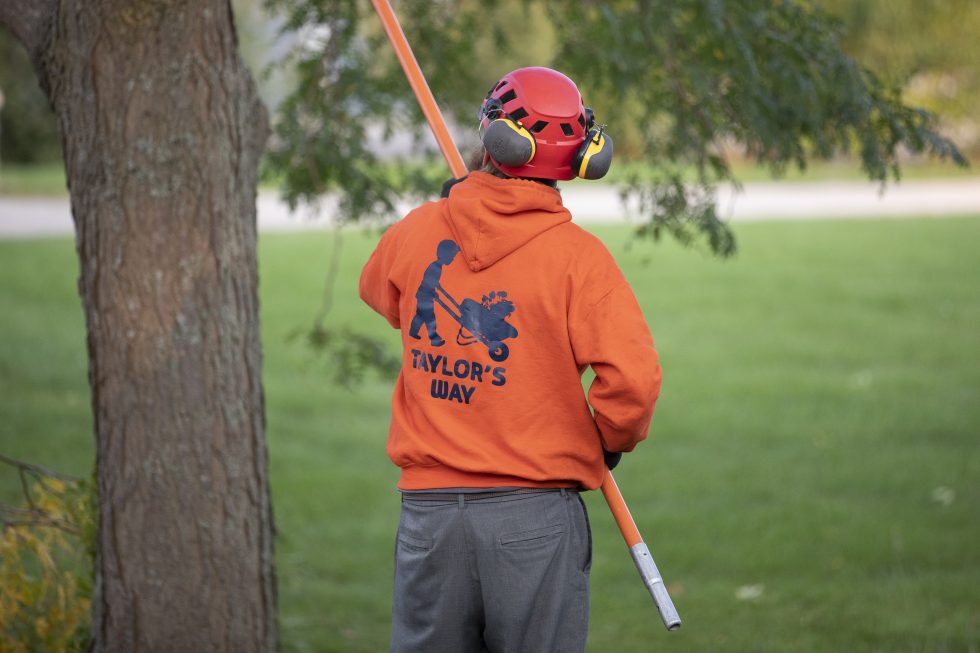by Taylor’s Way | Dec 15, 2022 | Blog

Winter is a great time to prune the most deciduous trees and shrubs. Complete pruning (thinning, correcting branch structure, dead and diseased wood) can be done to plants where flower blooms are not a critical factor. For ornamentals planted for their showy flowers its best
to wait until just after bloom to do extensive pruning but dead and diseased wood, structural correction and suckers and water sprouts can be removed in the winter. Evergreens and conifers, however, should be pruned during the growing season to avoid winter injury. Because deciduous trees and shrubs lose their leaves in the wintertime, it’s an ideal time to prune for proper branch structure. First prune any deadwood, water-sprouts and suckers. Dead wood is usually obvious when leaves are on the trees but in winter it may be a little more difficult to discern deadwood from live. Broken or diseased wood (especially fire blight infected pear limbs) may hold on to dead leaves even after the rest of the tree has lost its leaves for the season. The presence of fungus and lack of bark are also indications that a branch is dead. If you are still unsure if a branch is dead, gently scrape the outer layer of bark off a small twig on
the branch in question and check for a green layer just below the surface. Live branches will also be pliable and bend rather than snapping when bent. Giving the suspected dead branch a vigorous shake can be an easy way to locate deadwood, especially in shrubs and small trees. Spirea can often accumulate a lot of dead branches in the interior and underside of the plant. One highly efficient and effective method for removing deadwood in spirea is to first trim the plant back to 12-24”; this should leave the spirea looking like a porcupine. Next, while wearing sturdy boots or shoes, give the ‘porcupine’ a few short but firm kicks at the base of the plant. The dead branches will snap or loosen while the live branches will give and flex. Now all that needs to be done is to remove the dead branches with a spring or shrub rake or remove them with your hands (gloves are recommended for this).
Winter Dormant Trimming
Wintertime gives us an opportunity to catch up or get ahead of some of our landscape chores that maybe we’ve put off during the growing season. In fact, wintertime may be the preferred time to trim some of your trees and shrubs. Oaks, Elms, ornamental Pears and orchard trees should be pruned in winter to take advantage of the lower risk of spreading disease.
Hydrangeas, weigelia, Russian sage roses, and other summer and fall flowering shrubs can be pruned in winter as well, though some less-hardy shrubs might be better off waiting until just after budbreak in spring to have a better idea of what survived the winter.
When trimming shade and ornamental trees, remember to use proper pruning techniques. All cuts should minimize the exposed cross-section of the cut and limbs should be cut perpendicular to itself (not parallel to the trunk) and to within ¼” of the branch collar (the point where the branch meets the trunk forming a sort of shoulder on the underside.) Start by
pruning out dead wood, water sprouts and suckers. Waterspouts are rapidly growing vertical growth coming from the trunk or horizontal branches. This growth is very common on Ornamental pears and crabapples as well as fruit trees and trees under stress. Suckers form at
the base of the trees and are very common on grafted trees or trees that have had a major stress event like the loss of a major limb or trunk damage or heavy insect or disease damage. Next, prune rubbing and crossing branches and branches that are redundant or parallel to other
branches. From here the goal should be to open up the branch structure to allow for air flow. Be conservative here; you can always take out more, but you can’t put it back! Aim to prune only about 25% of the canopy in a season to avoid sending the tree into a stress response.
Uncover Plants Laden With Snow.
Winter storms can bring heavy snow and ice accumulations, potentially causing damage to your trees and landscape plants. Some conifers such as Arborvitaes are especially prone to snow loading resulting in broken branches and a ruined form to upright columnar cultivars. To prevent damage, vertical trunks can be tied together temporarily with nylon stockings, cotton rope, or specialty rubber tree chain as a semi-permanent and adjustable option. Shake off excess snow after heavy snowfall and let ice melt off naturally. For plants sensitive to ice damage, such as boxwoods, make sure gutters are clean to avoid melting ice and snow freeze on plants. In certain circumstances it may be useful to cover loosely with burlap or a shade cloth to prevent ice buildup on plants.
Keep Salt away From Your Plants!
Winter snow and Ice storms mean dealing with snow and ice accumulation on roadways, driveways, and sidewalks. Sometimes, these surfaces may need to have ice melts (salts) applied to them to ensure a safe surface. Often these areas are adjacent to lawns and landscape beds, putting them at risk from damage due to oversalting or using inappropriate products. Whenever possible, avoid the use of ice melts or salts in these areas. Removing as much snow and ice by shoveling if possible. If ice melts must be used, attention to product selection and the amount of product used can are critical to avoid damaging nearby turf and landscape plants. Sand or kitty litter can be used as an anti-skid material in these areas as an
alternative to ice melts if icing is minimal. The use of rock salt (Sodium Chloride) should be avoided or used sparingly; use alternatives to rock salt such as calcium chloride or magnesium chloride. These products have lower effective temperature ranges and are less harmful to plants though caution should still be maintained as overapplication can still cause injury to adjacent landscape and turf areas. Where salt injury may be unavoidable, it can help to maintain well-drained, non-compacted soils. In turf areas regular aeration and the use of gypsum can help with compaction. Salt builds up and may ruin soil structure over time and in extreme cases contaminated soil may need to be removed and replaced. If replacement is necessary, then addressing any underlying drainage issues would also be recommended at this time. Replacement soil should be free draining to allow salt to move through the soil profile.
Maintaining Tools
Wintertime is also a great time for maintaining and sharpening your garden tools. We often use and abuse our tools during the growing season, never quite finding the time to keep things in top condition. Shovels and spades can be cleaned, rust removed, point sharpened, handles sanded to remove splinters and surfaces oiled to prevent rust and preserve the wood. Pruners and loppers require a little more skill in bringing back to like new condition, but this is not out of reach especially with time, patience and a little elbow grease. Try to avoid the temptation to take your tools to the grinding wheel; this is especially important with fine cutting tools with
tempered edges such as pruners, loppers, axes, and knives. Grinding wheels tend to overheat the steel causing it to lose its temper resulting in a softer steel that is more prone to knicks, chips and dulling quickly. Power wire wheels, however, can be a quite efficient way to remove rust from tools. To remove nicks and gouges on cutting edges use a mill file instead. It’s important to keep a consistent bevel, as close to the manufacture’s original bevel as possible to save extra time and effort. Sometimes it’s easier and more thorough to take apart pruners and loppers to clean up interior rust, lubricate the fulcrum point, and put a superior edge on the
blade. On some pruner models the blades can be separated from the rest of the pruner body to be replaced entirely or easily cleaned and sharpened. Diamond files or fine grit sandpapers in increasing grit sizes (400, 600, 800 grit sandpapers will do for this) taped to a hard flat surface such as a piece of thick glass or smooth ceramic tile. On pruner blades it's critical to only sharpen the exterior face side, only lapping and removing the bur on the interior side. After cleaning and sharpening apply a dab of grease to the contact point and reassemble. After assembling, use spray lubricant to coat the exposed metal surfaces and wipe off the excess.
INDOOR ACTIVITY: If you’re stuck indoors and looking for something fun to do to pass the time this winter, The Morton Arboretum has many self paced e-learning modules about native trees and plants. Be sure to check out The Morton Arboretum Tree Collection module by clicking on this link and registering for free! https://mortonarb.org/explore/activities/adult-
programs/accredited-collections-at-the-morton-arboretum-online/
